Overview
We run through the key differences between DigitalOcean vs Vultr and benchmark them so you can see which is the best VPS provider for what you need, whether you want the cheapest possible server or the best performance for a larger budget. We tested several tiers, not just the cheap ones!
Whether you’re looking for the cheapest VPS or for the best performance for your dollar, shopping for the best VPS provider can be a maze of differing features and performance. In the past, we’d given an overview comparing DigitalOcean vs AWS, which are widely different. Today, we’ll be taking a close look at two competitors offering SSD based VPS solutions, both unmanaged. They offer similar options at similar prices, and choosing one over the other likely comes down to what features you need the most.

DDoS Protection
Vultr offers DDoS protection out-of-the-box while DigitalOcean does not, meaning you may need a third party solution like Cloudflare and a well-configured firewall. For DDoS protection on Vultr, it comes at a flat rate of 10 USD per month per server.
Downscaling
While upgrading on DigitalOcean, you have the option to upgrade the whole machine or everything but the drive to the new tier. Both cost the same, but if you upgrade a droplet and don’t increase the drive size, you can scale it back to the old tier. On Vultr, you can scale up but not back down, meaning that you’ll have to make a new smaller server and move everything to it manually.
OS Support
Vultr offers both Windows Server 2012 R2 and Server 2016 at 16USD per month, and with their custom ISO option, it’s easy to load whatever version you want. However, you can’t just drop any ISO in there. Windows ISOs will need to be modified with VirtIO drivers, a fairly simple and straightforward process outlined here. You also can’t directly upload an ISO to Vultr from your computer, you have to host it somewhere with a directly accessible URL and a maximum size of 8GiB. The alternative for semi or fully automated deployment is using an iPXE chain URL or iPXE script.
For official OS options, Vultr also offers the following. Each of these options has the last couple of long term versions to choose from.

In addition, you can choose from a list of preconfigured application installs, all based on CentOS.
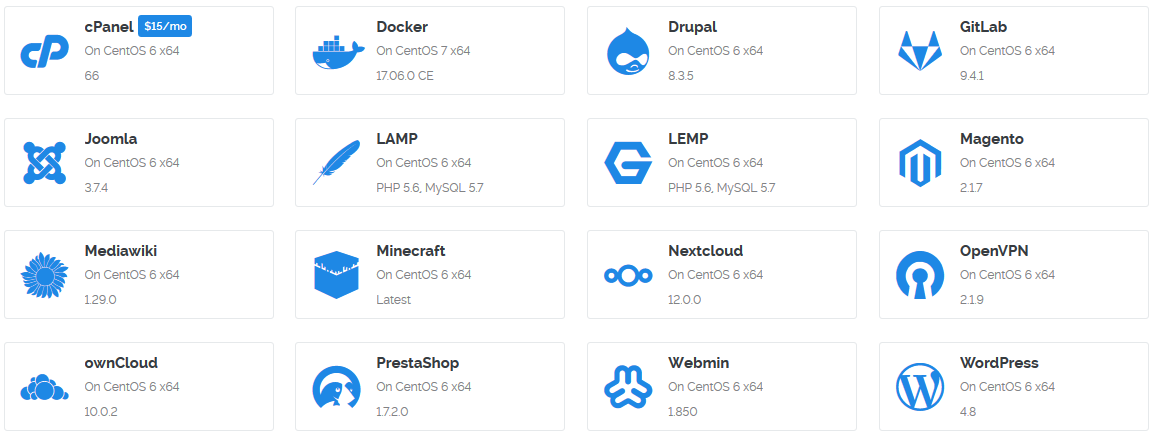
If you’d rather run a stock CentOS server with WHM/cPanel and configure it yourself, we have a helpful WHM/cPanel optimization guide here. There’s also an ISO library to choose from which makes for a pretty large selection of out-of-the-box options.
For DigitalOcean, while they have good application options as well, there are fewer OS options, and no custom ISO or iPXE option.

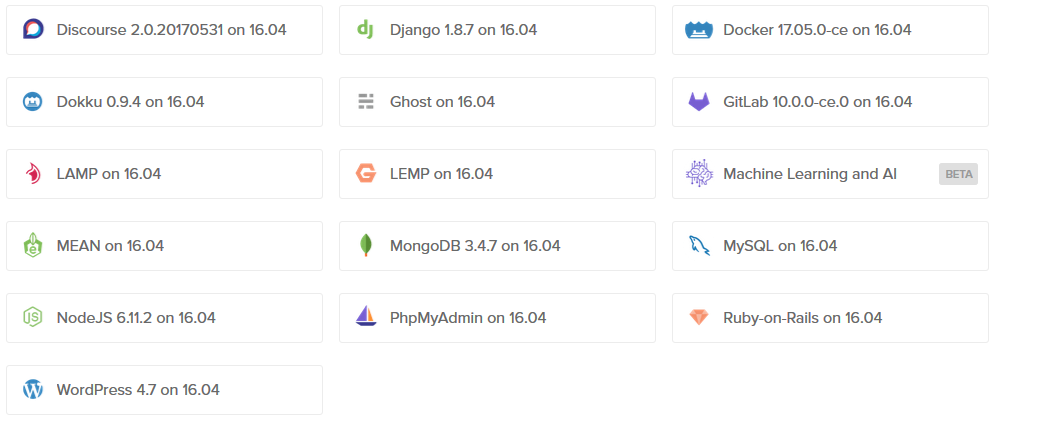
Both offer backups and IPV6. They both also now offer Private Networking. This adds an internal IP to your virtual machine, allowing communication between two instances in the same physical location to be incredibly fast, making it more appealing to deploy a small cluster of the best price/performance servers if you don’t need something centralized.
Pricing
Update – January 16, 2018
DigitalOcean has reached out and informed us that the their pricing has changed since this article was published. We would like to note that the pricing we listed for both DigitalOcean and Vultr reflect the pricing at the time of making this comparison, and is subject to change. Please check their respective websites for current pricing.
DigitalOcean has reached out and informed us that the their pricing has changed since this article was published. We would like to note that the pricing we listed for both DigitalOcean and Vultr reflect the pricing at the time of making this comparison, and is subject to change. Please check their respective websites for current pricing.
Below are the different tiers of basic virtual servers from both DigitalOcean and Vultr.
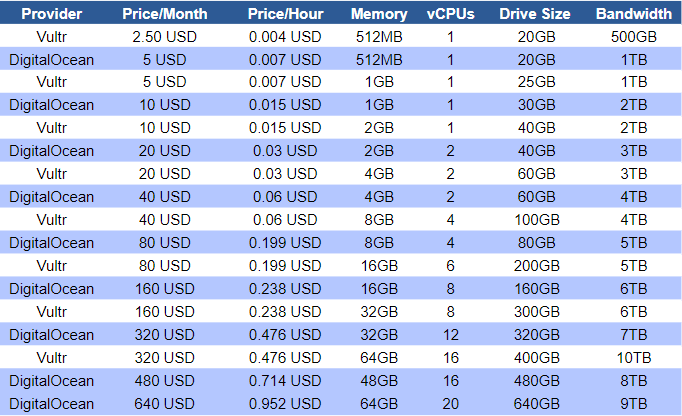
DigitalOcean vs Vultr prices as of 11/2/2017
Cost comparisons
If you’re going for CPU power, here is the cost breakdown for each tier. This is just the number of vCPUs, and actual performance may vary.
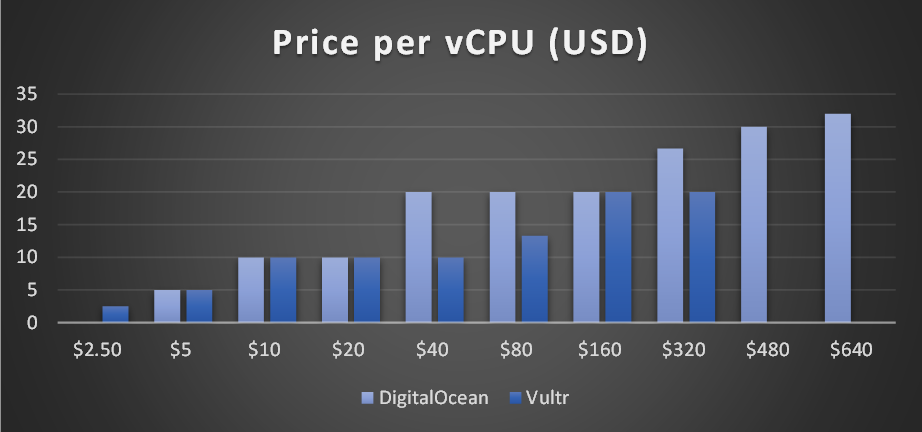
In the $40 to $320 USD options, Vultr is a better option for price to CPU power. DigitalOcean offers larger packages, while Vultr offers dedicated servers instead of these higher priced tiers.
All of the main storage is SSD based, so the cost per GB is much higher than spinning rust, but allows good random read and write times as well as quick access. Here’s how the cost per GB breaks down for each tier.
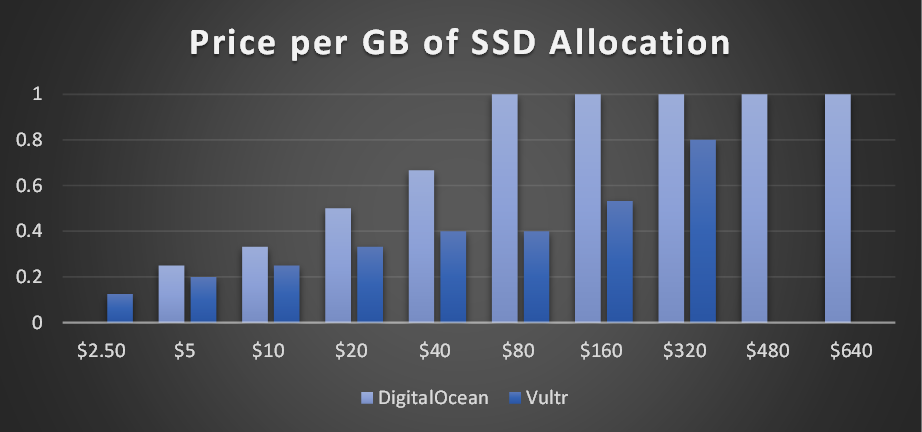
Once again Vultr comes out ahead for value, while DigitalOcean has larger offerings in higher tiers for included storage.
In addition to the included SSD space, DigitalOcean offers ‘spaces’ and Vultr offers ‘storage instances’ for slower yet cheaper mass storage. Vultr’s ‘storage instances’ cannot be mounted to existing servers as they can on DigitalOcean. This isn’t a big issue as utilizing the private networking feature and storage at the same place as your server will give you high speed access to it without using external bandwidth.
DigitalOcean Spaces starts at 5 USD a month for a 250GB space and 1TB of bandwidth, and scales from there based on how much ‘storage overage’ you are using. Each additional GB is 2 cents per month (same cost/GB as base price) and additional bandwidth is 1 cent per GB (twice the cost of the base 1TB). We cannot see the pricing of what Vultr offers as they are sold out of storage instances. Through research we were able to find that they offer different fixed sizes, and comes to about 4 cents per GB. Their bandwidth overage cost is also 1 cent per GB.
For users that want a faster storage solution, both offer SSD block storage options. Vultr’s is currently only available in the New Jersey location. It costs 10 cents per GB, and can be directly attached to your server there. The minimum size is 10GB. For DigitalOcean, block storage is also 10 cents per GB, but with a minimum size of 100GB. Block storage is available at most of their locations. All things considered, DigitalOcean has more to offer in terms of storage.
Bandwidth
Overages on Vultr cost 1 cent per GB in North America and Western Europe, 2.5 cents per GB in Singapore and Tokyo, and 5 cents per GB in Sydney. Overages can be limited in your account settings.
The usage is simply the larger usage between upload and download. For example, if you used 50GB incoming and 200GB outgoing, your total usage would be 200GB.
Also interesting to note is the hourly rates. From the Vultr website

DigitalOcean charges 1 cent per GB for overages with their storage instances, but does not appear to have any nuances to how that’s calculated. Since the FAQ section on their website was broken at the time of writing this, we reached out via support ticket to ask them about bandwidth usage on the regular droplets. They responded within hours.

So, currently, bandwidth limits on regular droplets are not enforced. Of course, one should check if that has changed since the time this article was written before deploying anything.
Network performance
What’s likely the most important thing to start with is picking a server close to you. In this area, Vultr has more choices. All of the available locations are on the map below. Vultr is shown in blue and DigitalOcean in orange.

For both Vultr and DigitalOcean, we made 2 servers in the US and one in Germany to test the network performance. We used the command line interface version of speedtest.net, which can be installed on Ubuntu like this
apt-get update apt-get install speedtest-cli speedtest-cli The tests were all done on 5 USD servers, as the tier didn’t seem to affect the speed. We chose the Speedtest server that was closest and gave the best results consistently, then did various tests at different times of the day.
To replicate the tests we’ve done, add the server ID listed to the command. For example, ID #5029 (AT&T New York)
speedtest-cli --server 5029For DigitalOcean, we tested three locations- NY3, NY1, and FRA1 (New York and Frankfurt).
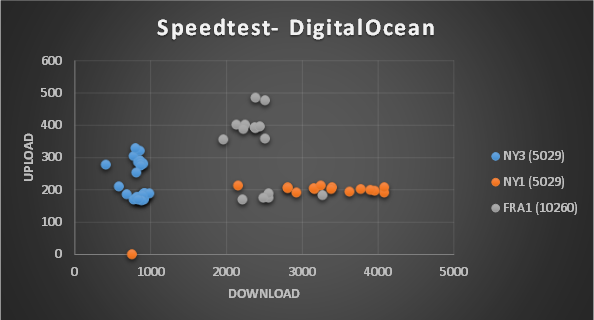
Average Ping: NY3 – 4.1, NY1-10.6, FRA1- 2.6
For Vultr, we tested NY(NJ), Seattle, and Frankfurt Germany

Average Ping: Frankfurt- 1.22, NY(NJ)- 3.2, Seattle- 2.3
A pleasant surprise was the good and consistent speed of Vultr given some negative reputation in the past for poor internet connections. A standout here is the Frankfurt Vultr server, delivering consistently high download as well as upload near or above 700 Mb/s.
Benchmarks
For these tests, we’ll be testing each tier up to 160 USD. We’ll not be touching dedicated machines, only virtual ones.
First, a CPU test. We tested all machines with sysbench up to 20,000 prime numbers.
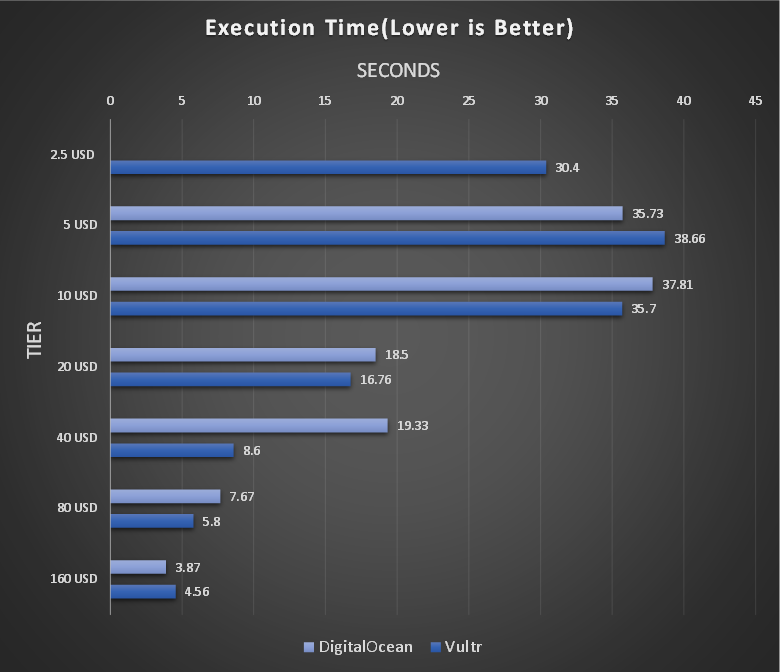
Next, the sysbench File I/O test. This will be a good indicator of random read/write performance. We ran it for 30 seconds and recorded the total operations performed in that time.

Next, memory performance. Operations per second, higher is better.
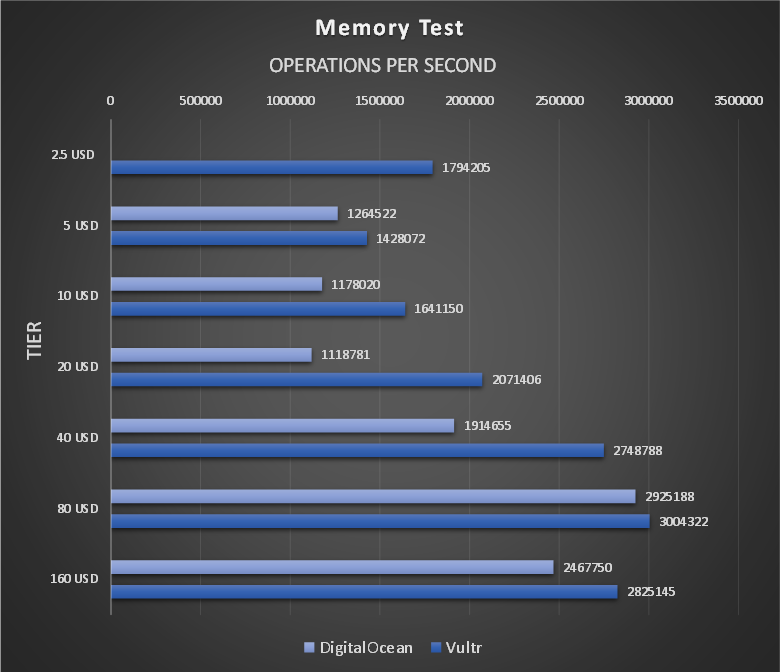
Finally, a more practical test- a sysbench MySQL test. Higher is better.
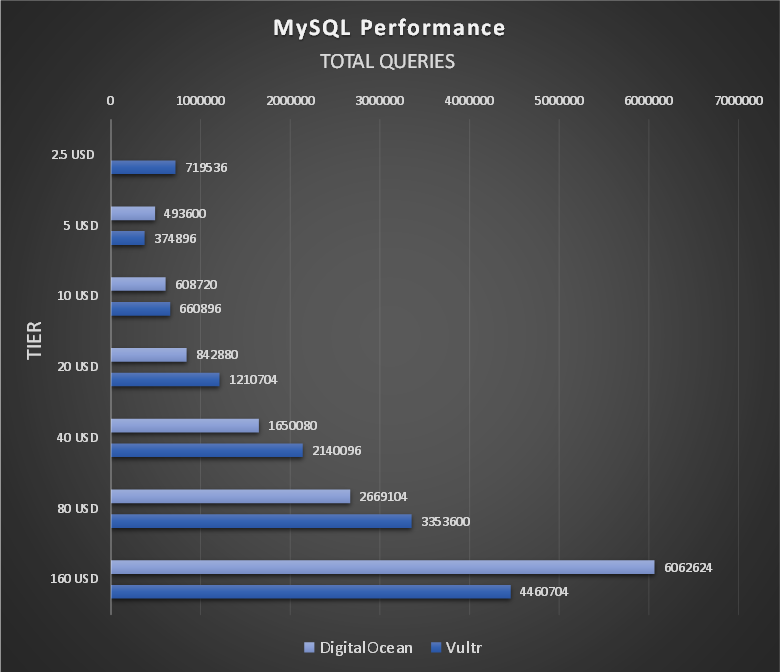
Other things to note
We found the DigitalOcean remote terminal to be a bit clunky and often froze on both Chrome and Firefox while the Vultr one worked very well, though it’s obviously not the only option for remoting in.
For the virtualization, Vultr is using QEMU, DigitalOcean is using Bochs.
The 2.50 USD option on Vultr seems to be more of a marketing gimmick than a real product. We were able to snag a couple to play with near the end of writing this article, but they were ‘sold out’ for most of the time we were testing and are sold out again now.
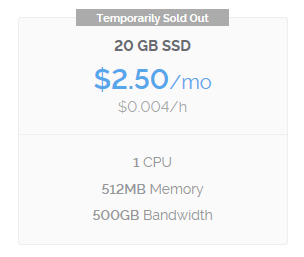
Conclusion
When comparing DigitalOcean vs Vultr both offer compelling feature and price differences over the other, and it really comes down to your use case. Is extra storage more important to you? Do you want to be able to downgrade your servers when you want? You’ll probably want DigitalOcean. Want included DDoS protection, better performance for your dollar, custom ISOs, or Windows? Vultr is your answer.

Share this article
16.3k reads
Similar Reads








